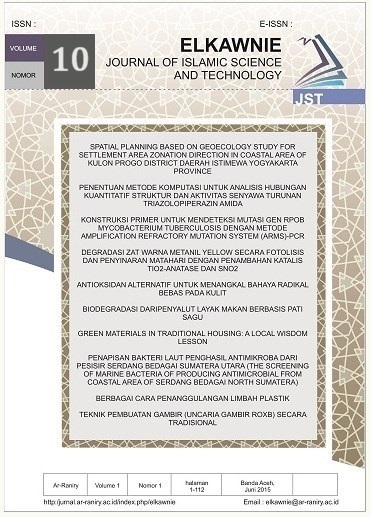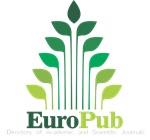Oil Recovery From Spent Bleaching Earth With Reflux Extraction Method Using Acetonitrile and n-Hexane Solvent
DOI:
https://doi.org/10.22373/ekw.v10i1.16791Keywords:
acetonitrile, n-hexane, oil recovery, reflux, spent bleaching earthAbstract
Abstract: The growth of the oleochemical industry generated a large amount of spent bleaching earth (SBE) solid waste that causes environmental problems. The SBE solid waste produced is reported at about 600,000 metric tons per year. Recovery of the oil from SBE can be an alternative solution to reduce the negative impact of SBE solid waste. In this study, the recovery of oil from SBE was carried out by the reflux extraction method followed by a study on its properties. The oil recovery process was conducted by using two different solvents (acetonitrile and n-hexane) at different particle sizes (40, 60, 100 mesh) of SBE, solvent-SBE ratios (2:1, 3:1, 4:1), and extraction time (1, 2, 3 hours). Experimental results showed that n-hexane extracted oil with yield ranged from 5 to 14.8%, while acetonitrile extracted oil with yield ranged from 0.68 to 8.4%. Product analysis shows that the oil extracted has a water content of 1.56% and 2.53% for acetonitrile and n-hexane, respectively. The viscosity analysis results show that the oil viscosities were 5.83 cSt (acetonitrile) and 5.09 cSt (n-hexane) which is in reasonable agreement with the Indonesian National Standard for vegetable oil (SNI 7709:2019). The result suggested that n-hexane provided better product yield than acetonitrile as a solvent for oil recovery from SBE. This study provides an alternative method and solution for the oleochemical industry in managing SBE waste.
Abstrak : Pertumbuhan industri oleokimia menghasilkan limbah padat berupa tanah pemucat (spent bleaching earth/ SBE) yang mengakibatkan permasalahan lingkungan. Limbah padat SBE yang dihasilakn dilaporkan sekitar 600.000 ton per tahun. Pemisahan minyak dari SBE dapat menjadi alternatif penyelesaian masalah untuk menurunkan dampak negatif dari limbah SBE. Dalam penelitian ini, recovery minyak dari SBE dilakukan dengan metode ekstraksi reflux dan dilanjutkan karakterisasi hasil minyak. Recovery minyak dilakukan dengan dua jenis pelarut (asetonitril and n-heksana) dengan ukuran partikel SBE bervariasi (40, 60, 100 mesh), perbandingan pelarut-SBE (2:1, 3:1, 4:1), dan waktu ekstraksi (1, 2, 3 jam). Hasil penelitian menunjukkan bahwa asetonitril mengekstrak minyak dengan yield 1,56-2,53%, sementara n-heksana berkisar 5-14,8%. Minyak hasil ekstraksi menunjukkan kadar air 1.56% (asetonitril) and 2.53% (n-heksana), serta nilai viskositas sebesar 5.83 cSt (asetonitril) and 5.09 cSt (n-heksana). Minyak hasil memenuhi SNI Minyak goreng sawit (SNI 7709:2019). Hasil menunjukkan n-heksana memiliki kemampuan lebih baik dibanding asetonitril dalam mengekstrak minyak dari SBE. Hasil penelitian memberikan penyelesaian alternatif dalam menagngani limbah SBE dari industri oleokimia.
References
Abdelbasir, S. M., Shehab, A. I., & Khalek, M. A. A. (2023). Spent bleaching earth; recycling and utilization techniques: A review. Resources, Conservation and Recycling Advances, 17(November 2022), 200124. https://doi.org/10.1016/j.rcradv.2022.200124
Amelia, S., & Maryudi, M. (2019). Application of natural zeolite in methylene blue wastewater treatment process by adsorption method. Jurnal Bahan Alam Terbarukan, 8(2), 144–147. https://doi.org/10.15294/jbat.v8i2.22480
Egbuna, S. O., Mbah, C. N., & Chime, T. O. (2015). Determination of the optimal process conditions for the acid activation of Ngwo Clay in the bleaching of palm oil. International Journal of Computational Engineering Research, 5(8), 17–29.
Elwardany, R. E., Shokry, H., Mustafa, A. A., & Ali, A. E. (2023). Influence of the prepared activated carbon on cellulose acetate for malachite green dye removal from aqueous solution. Macromolecular Research, 31(11), 1043–1060. https://doi.org/10.1007/s13233-023-00187-w
Fattah, R. A., Mostafa, N. A., Mahmoud, M. S., & Abdelmoez, W. (2014). Recovery of oil and free fatty acids from spent bleaching earth using sub-critical water technology supported with kinetic and thermodynamic study. Advances in Bioscience and Biotechnology, 05(03), 261–272. https://doi.org/10.4236/abb.2014.53033
Hartanti, D., & Theeravit, J. (2018). Extraction of the heartwood artocarpus lakoocha: the effects of method and material-solvent ratio to yield of extraction of the crude extracts. Pharmaceutical Journal of Indonesia, 15(01), 50–59.
Ketaren, S. (1986). Pengantar Teknologi Minyak dan Lemak Pangan. UI-Press.
Kuuluvainen, V., Mäki-Arvela, P., Eränen, K., Holappa, A., Hemming, J., Österholm, H., Toukoniitty, B., & Murzin, D. Y. (2015). Extraction of spent bleaching earth in the production of renewable diesel. Chemical Engineering & Technology, 38(5), 769–776. https://doi.org/https://doi.org/10.1002/ceat.201500052
Laila, L. (2017). Kaji eksperimen angka asam dan viskositas biodiesel berbahan baku minyak kelapa sawit dari PT. Smart Tbk. Jurnal Teknologi Proses Dan Inovasi Industri, 2(1), 3–6. https://doi.org/10.36048/jtpii.v2i1.2245
Li, Y., Fine, F., Fabiano-Tixier, A. S., Abert-Vian, M., Carre, P., Pages, X., & Chemat, F. (2014). Evaluation of alternative solvents for improvement of oil extraction from rapeseeds. Comptes Rendus Chimie, 17(3), 242–251. https://doi.org/10.1016/j.crci.2013.09.002
Low, A., Shamsuddin, R., & Siyal, A. A. (2022). Economic analysis of waste minimisation and energy recovery from spent bleaching earth. Cleaner Engineering and Technology, 7, 100418. https://doi.org/10.1016/j.clet.2022.100418
Machmudah, S., Maulana, N. A., Norman, A. S. M., Nyoto, V. M., Amrullah, I., Wahyudiono, Winardi, S., Wenten, I. G., & Goto, M. (2022). Oil removal from spent bleaching earth of vegetable oil refinery plant using supercritical carbon dioxide. Heliyon, 8(10). https://doi.org/10.1016/j.heliyon.2022.e10826
Melwita, E., Fatmawati, & Oktaviani, S. (2014). Ekstraksi minyak biji kapuk dengan metode ekstraksi soxhlet. Teknik Kimia, 20(1), 20–27.
Merikhy, A., Heydari, A., Eskandari, H., & Nematollahzadeh, A. (2018). Revalorization of spent bleaching earth a waste from vegetable oil refinery plant by an efficient solvent extraction system. Waste and Biomass Valorization, 10(10), 3045–3055. https://doi.org/10.1007/s12649-018-0311-0
Mu, B., & Wang, A. (2019). Regeneration and recycling of spent bleaching earth. Handbook of Ecomaterials, 5, 3147–3167. https://doi.org/10.1007/978-3-319-68255-6_121s
Muchtadi, T., & Sugiyono. (2010). Ilmu Pengetahuan Bahan Pangan. In IPB-Press. IPB-Press.
Naser, J., Avbenake, O. P., Dabai, F. N., & Jibril, B. Y. (2021). Regeneration of spent bleaching earth and conversion of recovered oil to biodiesel. Waste Management, 126, 258–265. https://doi.org/10.1016/j.wasman.2021.03.024
Nasir, S., Fitriyanti, F., & Kamila, H. (2009). Ekstraksi dedak padi menjadi minyak mentah dedak padi (rice-bran oil) dengan menggunakan pelarut n-hexane dan ethanol. Jurnal Rekayasa Sriwijaya, 18(1), 37–44.
Nezhdbahadori, F., Abdoli, M. A., Baghdadi, M., & Ghazban, F. (2018). A comparative study on the efficiency of polar and non-polar solvents in oil sludge recovery using solvent extraction. Environmental Monitoring and Assessment, 190(7). https://doi.org/10.1007/s10661-018-6748-6
Nugraha, Iriany, & Misran, E. (2023). Regeneration of spent bleaching earth using microwave assisted extraction method with hexane as solvent for the bleaching of crude palm oil. Journal of Physics: Conference Series, 2421(1), 012007. https://doi.org/10.1088/1742-6596/2421/1/012007
Nugroho, F. F., & Singgih, M. L. (2021). Feasibility study of waste utilization facilities in cement factory for spent bleaching earth. IOP Conference Series: Materials Science and Engineering, 1072(1), 012039. https://doi.org/10.1088/1757-899x/1072/1/012039
Nurasiah, E. S. (2010). Pengoptimuman ekstraksi andrografolida dari sambiloto dengan rancangan fraksional faktorial.
Oladosu, W. (2017). Recovery of vegetable oil from spent bleaching earth: stateof-the-art and prospect for process intensification. In Chemical Engineering Transactions (Vol. 56). https://doi.org/10.3303/CET1756023
Olar, H. R., Halafawi, M., & Avram, L. (2021). Petroleum and coal. Petroleum and Coal, 63(1), 278–283. https://doi.org/10.1142/9781786345882_0006
Raji, W. A., Abiodun, S. S., Adam, S. A., & Muhammad, S. S. (2018). Adsorptive bleaching of crude palm oil using activated plantain ( Musa Paradisiacal ) peel ash. International Journal of Scientific Engineering and Research, 6(7), 74–78.
Sabour, M. R., & Shahi, M. (2018). Spent bleaching earth recovery of used motor-oil refinery. Civil Engineering Journal, 4(3), 572. https://doi.org/10.28991/cej-0309116
Shahi, Mahsa & Sabour, Mohammad & Amiri, Allahyar & Ghasemnezhad, M. (2015). Cleaning spent bleaching clay through using solvent extraction method and RSM statistical approach. Cumhuriyet Science Journal. https://doi.org/1. 10.17776/csj.66920.
Shehab, A. I., Basir, S. M. A., Khalek, M. A. A., Soliman, M. H., & Elgemeie, G. (2019). Dye removal from aqueous solution by regenerated spent bleaching earth. International Journal of Chemical and Materials Engineering Vol:13, 13(9), 452–461.
Sumada, K. (2022). Bleaching earth recovery from waste to purify coocking oil by extraction–activation method. Journal of Research and Technology, 8(2), 169–177.
Susanty, S., & Bachmid, F. (2016). Comparison of maceration and reflux extraction methods to phenolic levels of corn cob extract (Zea mays L.). Jurnal Konversi, 5(2), 87.
Tim Riset PASPI. (2020). Spent bleaching earth (SBE) harta terpendam dari limbah industri refinery sawit. Palm Oil Journal, 1(20).
Utami, S., & Nastiti Siswi Indrasti, M. (2020). Pemulihan minyak sawit dari spent bleaching earth dengan metode ekstraksi refluks palm oil recovery through reflux extraction from spent bleaching earth. Jurnal Teknologi Industri Pertanian, 30(1), 90–99.
Utomo, S. (2016). Pengaruh konsentrasi pelarut (n-heksana) terhadap rendemen hasil ekstraksi minyak biji alpukat untuk pembuatan krim pelembab kulit. Jurnal Konversi, 5(1), 39. https://doi.org/10.24853/konversi.5.1.39-47
Yulikasari, A., Nurhayati, E., Utama, W., & Warmadewanthi, I. (2022). Characterization of Spent Bleaching Earth as an Adsorbent Material for Dye Removal. Journal of Ecological Engineering, 23(4), 96–104. https://doi.org/10.12911/22998993/146353
Zhang, Q. W., Lin, L. G., & Ye, W. C. (2018). Techniques for extraction and isolation of natural products: A comprehensive review. Chinese Medicine (United Kingdom), 13(1), 1–26. https://doi.org/10.1186/s13020-018-0177-x
Downloads
Published
Issue
Section
License
Proposed Policy for Journals That Offer Open Access Authors who publish with the Elkawnie journal agree to the following terms:
a. Authors retain copyright and grant the journal right of first publication with the work simultaneously licensed under a Creative Commons Attribution License that allows others to share the work with an acknowledgement of the work's authorship and initial publication in this journal.
b. Authors are able to enter into separate, additional contractual arrangements for the non-exclusive distribution of the journal's published version of the work (e.g., post it to an institutional repository or publish it in a book), with an acknowledgement of its initial publication in this journal.
c. Authors are permitted and encouraged to post their work online (e.g., in institutional repositories or on their website) prior to and during the submission process, as it can lead to productive exchanges, as well as earlier and greater citation of published work (see The Effect of Open Access).

























